Introduction
Les applications Earth Engine sont des interfaces utilisateur dynamiques et partageables pour les analyses Earth Engine. Avec les applications, les experts peuvent utiliser des éléments d'interface utilisateur simples pour exploiter le catalogue de données et la puissance d'analyse d'Earth Engine, ce qui permet aux experts et aux non-experts de l'utiliser.
Les applications publiées à partir d'Earth Engine sont accessibles via l'URL spécifique à l'application générée au moment de la publication. Aucun compte Earth Engine n'est requis pour afficher ou interagir avec une application publiée. Les applications sélectionnées comme sélectionnées par leur créateur sont également disponibles dans une galerie d'applications spécifique à l'utilisateur (par exemple, USERNAME.users.earthengine.app).
Créer votre application
Les applications Earth Engine peuvent exploiter la plupart des mêmes fonctions que celles utilisées dans l'éditeur de code, à quelques exceptions près. De plus, nous avons conçu l'API d'interface utilisateur en tenant compte des développeurs d'applications. Si vous ne connaissez pas l'API User Interface, consultez la présentation de l'API UI.
Publier votre application
Pour publier une application depuis l'éditeur de code, commencez par charger le script que vous souhaitez transformer en application, puis ouvrez le panneau de gestion des applications, auquel vous pouvez accéder en cliquant sur le bouton Applications au-dessus de la section du script dans l'éditeur de code.

Cliquez ensuite sur le bouton NEW APP (NOUVELLE APPLICATION).

Dans la boîte de dialogue, choisissez l'accès éditeur, un nom d'application, sélectionnez un projet Google Cloud et spécifiez l'emplacement du code source de l'application. Limitez l'accès à cette application à un groupe Google spécifique ou laissez-la accessible au public à l'aide des options disponibles dans l'onglet "Restriction". Pour les applications accessibles au public, vous pouvez également fournir une image d'aperçu personnalisée pour l'application, ainsi qu'une description dans l'onglet "Galerie". Cliquez sur "Mettre en avant cette application dans votre galerie d'applications" si vous souhaitez qu'elle figure dans votre galerie d'applications publique disponible sur USERNAME.users.earthengine.app. Vous pouvez éventuellement inclure un logo personnalisé en haut à gauche de l'application en important une image de votre choix depuis l'onglet "Logo".
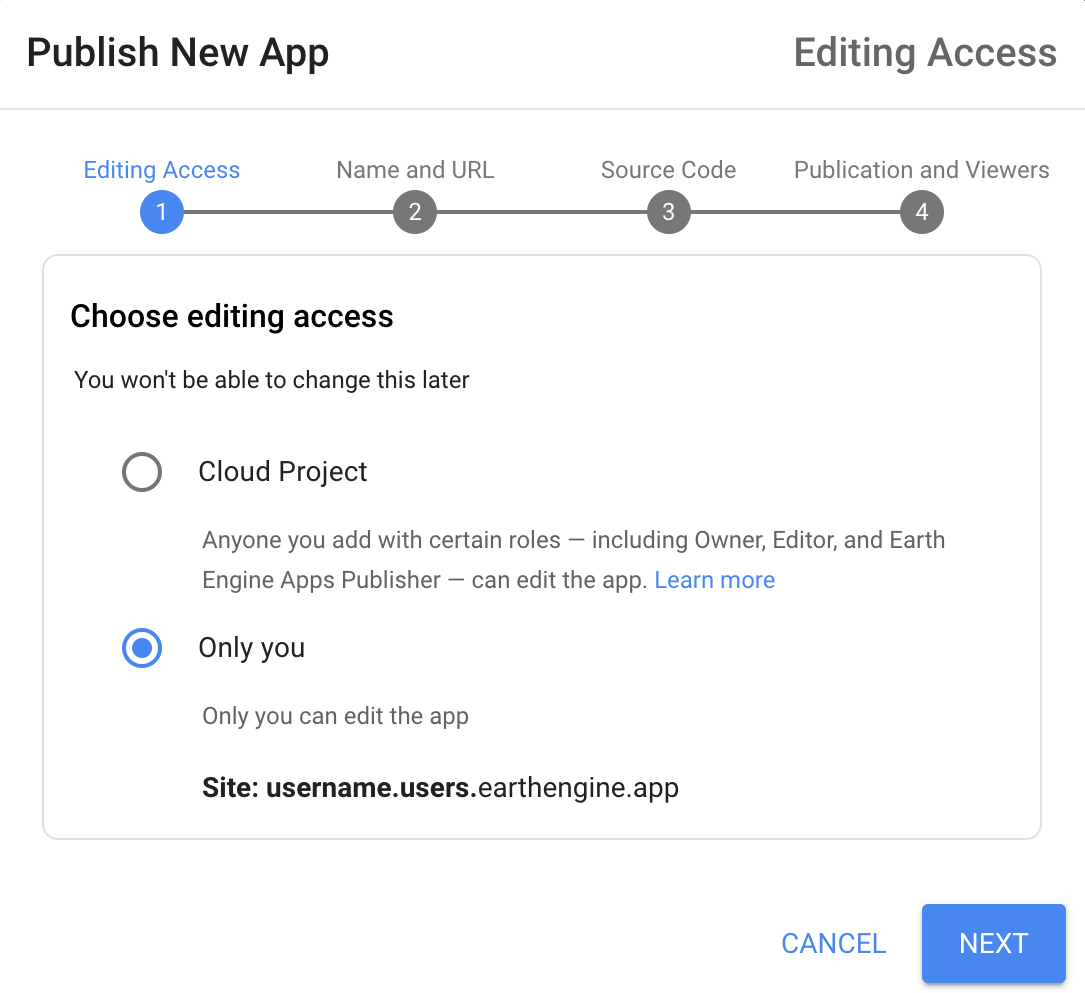
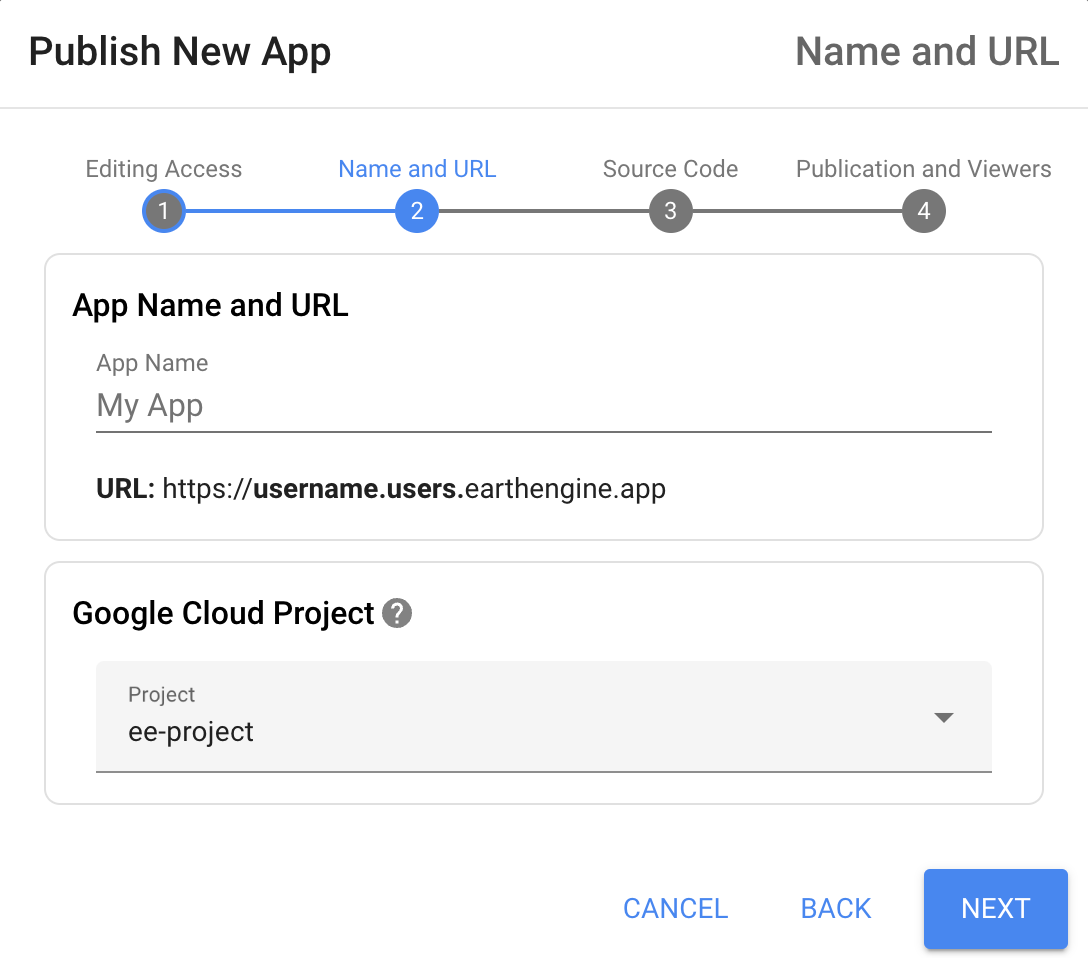
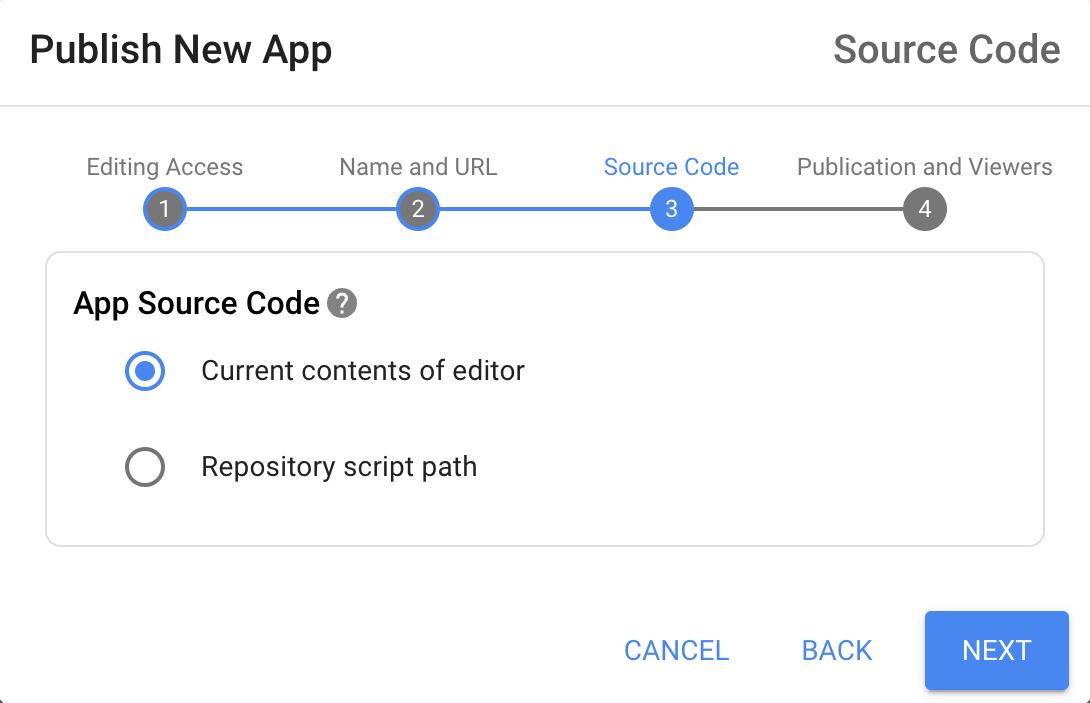
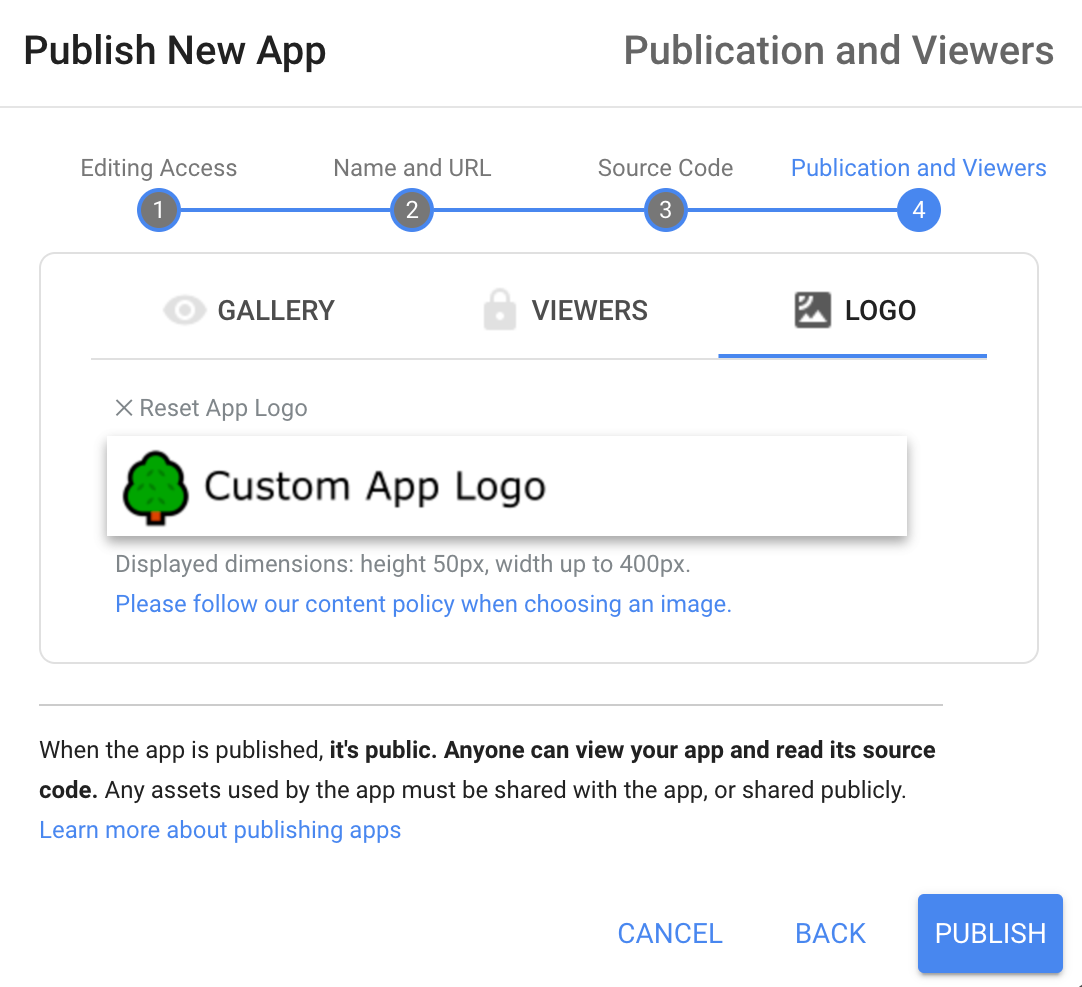
Gestion de vos applications
Pour gérer une application depuis l'éditeur de code, ouvrez le panneau de gestion des applications en cliquant sur le bouton Applications au-dessus de la section de script dans l'éditeur de code. Vous pouvez ensuite modifier la configuration de votre application ou la supprimer.
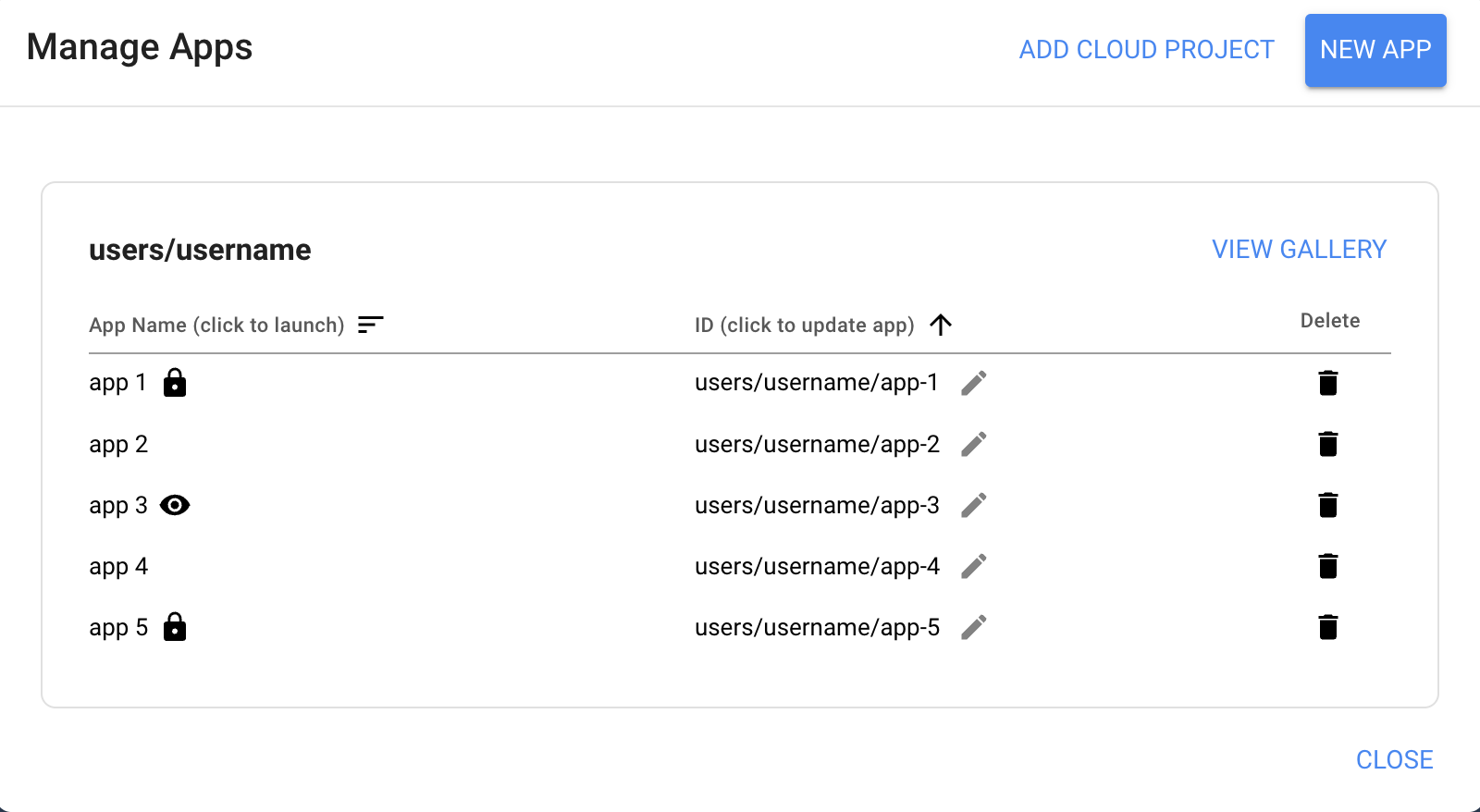
Collaborer avec d'autres utilisateurs sur des applications appartenant à un projet
Par défaut, vous êtes le seul à pouvoir modifier les applications que vous publiez sous votre nom d'utilisateur. La collaboration sur les applications est possible avec les applications appartenant au projet. Les applications appartenant à un projet sont des applications détenues et publiées dans un projet Cloud. Toute personne disposant du rôle IAM Éditeur d'applications Earth Engine peut modifier et supprimer les applications publiées dans le projet Cloud. En savoir plus sur les rôles IAM Earth Engine
Pour activer les applications appartenant au projet, sélectionnez l'option Projet Cloud à l'étape "Choisir l'accès en modification", puis sélectionnez le projet Cloud que vous souhaitez utiliser. Terminez ensuite le processus de publication de l'application comme d'habitude. L'application sera publiée sur le domaine PROJECT-ID.projects.earthengine.app et pourra être modifiée par toute personne disposant du rôle IAM "Éditeur d'applications Earth Engine" sur le projet Cloud.
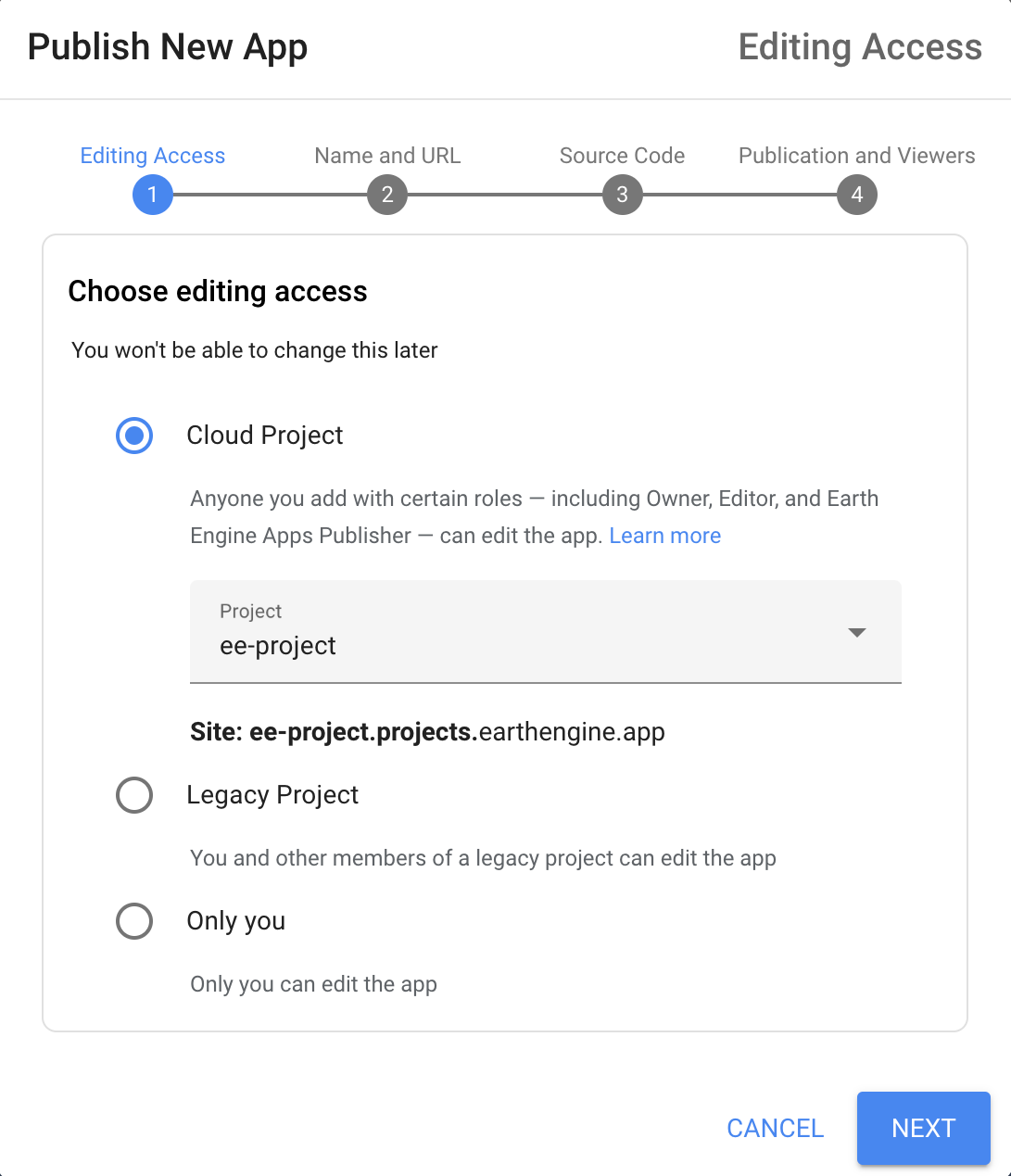
Pour afficher les applications d'un projet Cloud, appuyez sur le bouton AJOUTER UN PROJET CLOUD, puis sélectionnez le projet Cloud.

Pour partager le projet Cloud avec d'autres utilisateurs, appuyez sur le bouton PARTAGER LE PROJET. Vous accédez alors à la page IAM de Cloud Console du projet, où vous pouvez attribuer aux collaborateurs le rôle IAM d'éditeur d'applications Earth Engine.
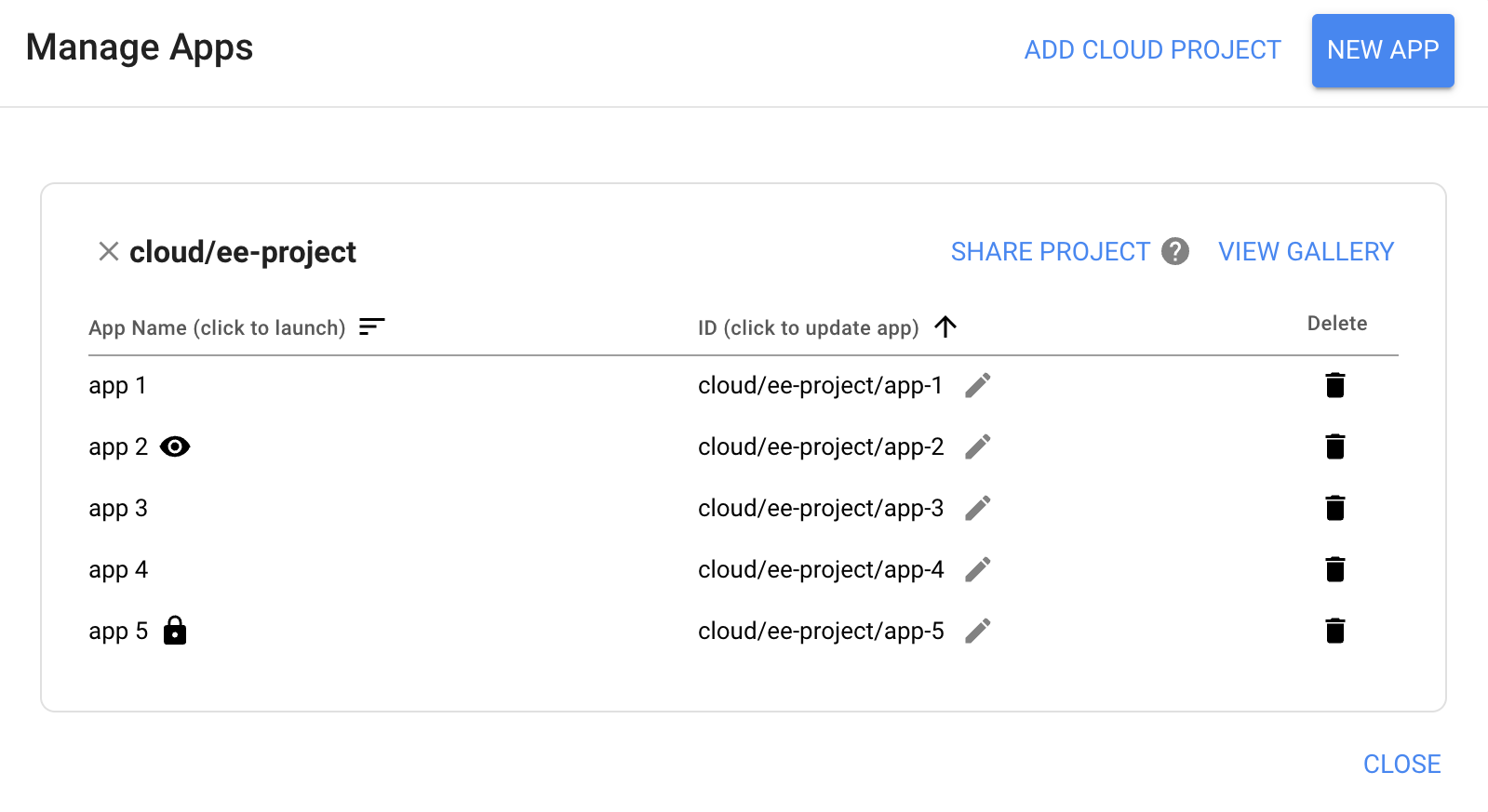
Questions fréquentes
- Comment supprimer une application de ma galerie d'applications ?
- La case à cocher "Mettre en avant cette application" sur la page de configuration de l'application indique si une application doit apparaître ou non sur la page "Applications sélectionnées". Les applications en accès limité ne peuvent pas être mises en avant.
- Mon code Earth Engine est-il visible ?
- Oui, par toute personne pouvant accéder à l'application. Bien qu'il ne soit pas clairement visible lorsque votre application est publiée, il est assez facile pour quelqu'un de consulter le code JavaScript de votre application en observant le trafic réseau vers son navigateur Web. Dans Chrome, par exemple, le code JavaScript est visible dans le panel Network (Panneau "Réseau") des outils pour les développeurs.
- Quelles sont les causes possibles de l'erreur "Une erreur s'est produite lors du chargement de certaines parties de la carte" pour une application publiée ?
- Assurez-vous que tous les composants Image ou Tableau utilisés dans votre application sont partagés publiquement ou avec l'application. Dans la boîte de dialogue de partage d'éléments, sélectionnez l'option "Tout le monde peut lire" ou choisissez le nom de l'application dans la liste déroulante. Pour les applications limitées à un groupe Google, le partage d'un composant avec ce groupe Google ne le rendra pas visible par l'application. Les composants doivent être partagés avec l'application ou publiquement.
- Pourquoi la page "L'application n'est pas encore prête" s'affiche-t-elle ?
- Une fois une application créée, la propagation des informations dans le système peut prendre un certain temps. Ce problème est généralement résolu en quelques minutes. Si l'erreur persiste, veuillez contacter l'assistance.
- Pourquoi mes géométries dessinées s'affichent-elles dans mon application ?
- Vous pouvez ainsi afficher facilement des géométries de référence dans votre application et créer des applications dans lesquelles les utilisateurs peuvent modifier les géométries. Si vous ne souhaitez pas que certaines géométries soient affichées ou modifiées, vous pouvez masquer ou verrouiller des calques de géométrie individuels pour empêcher les utilisateurs de les voir ou de les modifier avant de publier votre application. Pour en savoir plus, consultez la documentation sur les outils de géométrie.
- Qu'est-ce qu'un quota d'application ?
- Pour éviter que des scripts erronés ou gourmands en ressources n'aient un impact négatif sur la disponibilité du service, Earth Engine applique des quotas d'utilisation des applications aux requêtes simultanées. Ce quota fonctionne de la même manière que le quota par utilisateur d'Earth Engine, sauf qu'il est associé à l'application plutôt qu'à un utilisateur spécifique.
- Chaque application que je crée dispose-t-elle de son propre quota ?
- Oui, un quota distinct est associé à chaque application. Pour les anciennes applications créées avec une clé API, le quota est associé au projet Cloud à partir duquel vous générez la clé API d'une application. Si vous générez plusieurs clés API à partir du même projet Cloud, elles partageront toutes le même quota d'utilisation.
- Pourquoi faut-il un compte de facturation Cloud ? Mes applications me seront-elles facturées ?
- Nous utilisons Google Cloud Platform pour diverses tâches en coulisse. La création d'une application Earth Engine ne vous sera pas facturée. Toutefois, Google Cloud Storage n'est pas sans frais. Par conséquent, si vous choisissez d'exporter les résultats de vos analyses vers Google Cloud Storage, des frais peuvent vous être facturés.
- Comment mieux comprendre l'utilisation et les quotas de mes applications ?
-
Si le quota est dépassé, Earth Engine peut renvoyer des erreurs
HTTP 429: Too Many Requests. En général, ces erreurs sont gérées par la bibliothèque cliente Earth Engine, qui encapsule les requêtes dans un délai avant expiration exponentiel, et réessaie la requête jusqu'à ce qu'elle aboutisse. La bibliothèque cliente Earth Engine relancera la requête cinq fois.Si votre application devient si populaire que de nombreux utilisateurs reçoivent des erreurs de dépassement de quota, un message d'avertissement s'affiche et Earth Engine peut être amené à restreindre (temporairement) l'accès à l'application.
Pour éviter de recevoir des erreurs 429, vous pouvez activer le stockage en cache pour votre application, par exemple en stockant des statistiques agrégées pouvant être mises en cache en tant qu'éléments de table Earth Engine, plutôt que de les calculer instantanément.
